A new school building typically generates excitement and boosts the morale of the students and teachers that will fill the classrooms, as well as the surrounding community. The tangible and sizable investment in education sends a message that schooling is important and providing high-quality learning environments for students is a priority.
Less attention-getting are the more mundane but necessary facility renovations that do not merit ribbon cuttings or showy celebrations, but may enable a learning space to ward off deterioration and remain effective. And maybe the routine nature of those renovation is the reason that education institutions, having to set priorities with limited spending authority, tend to consider those improvements and other building maintenance projects as less than urgent and push them to the back burner. The pattern has been evident through generations of school funding, and the result is an education system sagging under the weight of inadequate facilities plagued by deferred maintenance.
Although an increased focus on the problem beginning in the 1990s produced some progress in improving the nation’s school facilities, budgets over the last decade or so since the 2008 recession tell a familiar story: insufficient funding of public schools has caused the gap to widen between what schools need and what they receive to provide suitable learning spaces for students.
Although thousands of school renovations have been carried out over the years to improve learning spaces for students, thousands more facilities that need similar attention are not getting the resources needed to provide a suitable educational environment.
“No matter how good the curriculum, the teachers or the administrators, we can’t achieve world-class education with crumbling school facilities,” says a new report, “2021 State of our Schools,” produced by the 21st Century School Fund, the International WELL Building Institute and the National Council on School Facilities.
The problem, the report concludes, comes down to this: Schools aren’t getting enough funding to address their facility needs; the money they do get is not reaching the schools and communities that need it the most, and the methods used to acquire funds places a sometimes insurmountable burden on local communities.
The gap grows
The 2021 State of our Schools report is a followup to a 2016 study that calculated a gap of $46 billion ($60 billion in 2020 dollars) between what U.S. school districts were spending on facilities and what they needed to spend to bring the nation’s public school facilities up to modern standards.
The numbers in the latest report show that the situation has gotten much worse, even though school districts have been spending $110 billion a year on maintaining and upgrading facilities.
“Unfortunately, five years later, we have found that this gap has increased to a staggering $85 million every single year,” the report says. “This is the case despite the significant efforts that communities are making to provide safe, healthy and adequate public school facilities.”
Here’s how researchers arrived at that number. For maintenance and operations, they stated that to meet good stewardship standards for cleaning, routine and preventive maintenance, minor repairs and utility costs, school systems should be spending 3% of their facilities’ current replacement value. That amounted to more than $83.5 billion in 2018-19. But average maintenance and operations spending in fiscal years 2017 to 2019 was a little less than $56 billion—a deficit of more than $27.5 billion.
For capital investments, the report says schools should invest 4% of their current replacement value—2% on capital renewal (replacing systems, components, furniture, fixtures and equipment; 1% for alterations (building and site changes to address education, environmental, site and resiliency design deficiencies), and 1% to address backlogs in deferred maintenance. That amounts to $111.4 billion; actual capital investments from fiscal 2009 to 2019 came to an average of $54.1 billion—shortfall of $57.3 billion. Combining the capital spending shortfall and the maintenance spending shortfall brings the total to nearly $85 billion a year.
Because of that chronic underfunding, too many students in the United States are attending classes in facilities that fall short of providing 21at-century learning environments. The Covid-19 pandemic has made the situation more dire, as schools were forced at a moment’s notice to deal with a critical community health crisis with buildings and equipment that in many cases were not up to the task.
“The pandemic has disrupted continuity of education, widened disparities in academic achievement and take the lives of students, teachers and staff,” the report says. “When they enter their classrooms, it is likely that they enter spaces that suffer from long-standing deferred maintenance and modernization needs, spaces that have seen few meaningful health and safety improvements since the start of the pandemic.”
Funding inequities
The impact of inadequate facilities is not evenly distributed, the State of our School report says.
“Some students are in state-of-the-art public school facilities that make the news and impress us with their brilliance and beauty,” the report says. “However, other students—primarily in high-poverty districts and often children of color in distressed communities—attend schools in deteriorated and substandard facilities.”
The report found that from fiscal 2016 to 2018, low-poverty districts spent nearly $200,000 a year more per school on annual maintenance and operations than high- and medium-poverty districts. It also found that high-poverty districts spent 37% less per school on capital investments than low-poverty districts.
“Economically disadvantaged students disproportionately attend schools that have not had the dollars for necessary facilities maintenance, operations or modernizations,” the report says. “This means they are learning in classrooms lacking air conditioning or eating lunch in an outdated cafeteria that doubles as a gym, attending schools with pest problems, legacy toxics, and without educational enhancements and supports that retain teachers or students in schools.”
Schools in rural areas also are more likely to have substandard learning spaces.
“In every income group, rural school districts have had on average, lower maintenance and operations spending and capital investments per school than any other geographic area,” the report says.
Local burden
The numbers clearly show that public schools need more funding to upgrade their facilities sufficiently. But most local districts in the United States must acquire money for capital improvements without much help from state or federal coffers.
The State of our Schools report notes that capital outlay for elementary and secondary public education is the second-largest sector for state and local construction, after highways, but the funding sources for the two sectors diverges greatly.
“Unlike transportation, which has most of its capital costs paid from federal and state sources, local school districts bear the heaviest responsibilities for construction capital spending,” the report says.
Local school districts paid 77% of the costs for preK-12 capital projects from fiscal 2009 to 2019, while states paid 22% and the federal government contribute 1%. And the support provided by states varies widely—11 states contribute nothing, and eight states pay more than 50% of costs.
With such a high burden on local districts, many of them do not have the size or tax base to address the needs of their aging school facilities.
“Low wealth and small districts do not have sufficient revenue from local property or sales tax, or other sources of revenue to finance enough borrowing to address their accumulated deficiencies from aged infrastructure,” the report says.
The funding gap has been made worse by the declining support for school capital projects from states in the last decade. In fiscal 2011, states provided $15.9 billion (in 2020 dollars) to districts; that amount has dropped every year through fiscal 2019, when states allocated $9.7 billion to districts.
Federal assistance
In addressing how to upgrade school facilities, the federal government is "a prominent missing partner," the report asserts.
"With no federal legislative program to address the educational facilities’ needs of low wealth and high need school districts, the U.S. Department of Education has not integrated issues related to the built environment of schools into its school improvement and equity strategies," the report says. "To date, there is no dedicated program or office in the U.S. Department of Education that has staffing and technical capacity to provide support to states or districts on school facilities data, research or best practice."
Business as usual will not make the $85 billion funding gap go away, the report says. Systemic policy changes are needed.
"Even increasing funding alone will not remedy the structural inequities and shortcomings of our nation’s public education infrastructure," the report says. "Modernizing our public school infrastructure for all students and communities will take a vision, resolve and a local, state and federal systemic reforms.”
Sidebar: New life for life insurance building
Renovating an existing office building is one way for charter schools, which typically don’t have ready access to construction funding, to acquire an affordable home.
That is the path Larchmont Charter School in Los Angeles took to open Larchmont Charter at Lafayette Park, its high school for grades 8 to 12.
Chava Danielson, architect with DSH // architecture, which designed the building renovation, said Larchmont leaders looked at several other buildings before choosing the old insurance building.
“There were some more conventional, easily imaginable sites on the table, but they were far from public transportation (which would undermine the mission of outreach to mixed socioeconomic student body) and were not convenient to facilities such as a park and library that provide opportunities to round out the offerings of a high school site,” Danielson said.
Designers determined that the shell of the building offered the opportunity for light-filled classrooms of operable windows with views both across the building interior and outward toward the city.
Before the space could be suitable for a school, designers had to work through and undo decades of insensitive renovations and poor maintenance programs.
The building interior was completely renovated with new systems, lighting and finishes, and a completely reconfigured floor plan was put into place.
A vintage custom aluminum curtain wall and its operable windows were repaired and reused. Lighting was upgraded with energy efficient fixtures and dynamic daylight-responsive controls.
The adaptive reuse of 34,000 square feet of space has provided 23 classrooms for 600 students.
“The adaptive reuse of this building to a grade 8-12 school site is the realization of a 21st-century campus in the heart of the city: modern, sustainable, flexible, open to its environment and supportive of a diverse, involved community of stakeholders," the school says.
[sidebar 2]
New space for a second century
The Washington, D.C. school system has reopened the more than 100-year-old Eaton Elementary School after a $57.7 million renovation. The project began in 2018 with the renovation of two existing buildings totaling 40,000 square feet and the demolition of interconnecting buildings that allowed for the construction of a new 45,000 square feet three-level building. The new facility features a new gymnasium, library, and cafeteria to serve the student body.
“We are excited to welcome our Eaton community back to their school home,” says Chancellor Lewis D. Ferebee. “The new school building celebrates our history and embraces the bright future of our students at the heart of the design.”
The original Eaton building was constructed in 1910, and was undersized for the school’s current population. The renovated campus is built to accommodate about 490 students.
The renovation was able to fit the expanded space onto a small lot surrounded by four streets with varying grade elevations, district officials said. Students were relocated to portable classrooms at the University of District of Columbia while the Eaton campus was renovated.
New features of the renovated Eaton Elementary School include:
- Two new elevators – providing ADA accessibility from one floor to the next and all new ADA-accessible exterior doors. ·
- MEP systems, a green roof, new wifi system with several indoor and outdoor wireless access points, and upgraded security including cameras.
- A a packaged water-cooled system with energy recovery. Outdoor air is delivered directly to each space through dedicated ventilation air terminal units and diffusers.
- A water-cooled VRF system with central cooling tower and gas-fired hot water boilers. Larger areas such as the library, gym, kitchen, and dining areas are served by water-source heat pumps.
About the Author
Mike Kennedy
Senior Editor
Mike Kennedy, senior editor, has written for AS&U on a wide range of educational issues since 1999.


